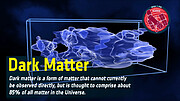These visuals feature artist impressions.
Dark Matter
Dark matter is a form of matter that cannot currently be observed directly, but is thought to comprise about 85% of all matter in the Universe.
Objects in our Universe are attracted to one another by gravity. The more mass an object has, the stronger its gravitational attraction. The effects of gravity can be observed across our Universe: planets orbit the Sun; exoplanets orbit other stars; galaxies interact and collide; and so on. If the mass of a celestial object is known, then it is possible to calculate how it will interact with other celestial objects via gravity. However, calculations based on observations of many galaxies often do not work out in practice. The galaxies appear to lack sufficient mass to be held together by gravity — they should fly apart, or should never have formed at all, according to the laws of gravity. Therefore, many astronomers have theorised that there must be a form of matter that has not yet been observed, known as dark matter, which is holding these galaxies together. For the calculations based on observations to make sense, dark matter must make up about 85% of all the matter in our Universe, and 27% of our Universe’s total mass-energy density. It is referred to as ‘dark’ because it does not appear to interact with the electromagnetic field, and therefore does not seem to emit, reflect or refract light.
Hubble carried out surveys and developed new methods to look for clues about dark matter. By analysing the COSMOS survey — one of the largest surveys undertaken with Hubble — an international team of scientists assembled one of the most important results in cosmology: a three-dimensional map that offers a first look at the web-like large-scale distribution of dark matter in the Universe. This historic achievement in 2007 accurately confirmed standard theories of dark matter structure formation, and took astronomers from inference to a direct observation of dark matter's influence in the Universe. Mapping dark matter's distribution in space and time is fundamental to understanding how galaxies grew and clustered over billions of years. Tracing the growth of the clustering of dark matter may also eventually shed light on dark energy, a force which repels matter rather than attracts it as gravity does, which may have influenced how dark matter clumps.
In 2009, Hubble uncovered strong new evidence that galaxies are embedded in halos of dark matter. Peering into the tumultuous heart of the nearby Perseus galaxy cluster, Hubble discovered a large population of small galaxies that have remained intact while larger galaxies around them are being ripped apart by the gravitational tug of other galaxies. This provided further evidence that the undisturbed galaxies are enshrouded by a ‘cushion’ of dark matter that protects them from the rough-and-tumble in their neighbourhood.
Hubble also solved the mystery of the galaxy NGC 1052-DF4 in 2020, which appeared to be missing most of its dark matter. Astronomers concluded that the gravitational forces of a neighbouring galaxy stripped the dark matter from NGC 1052-DF4 and now the galaxy is being torn apart. The discovery not only solved an astronomical conundrum, but has also brought a sigh of relief to astronomers. Without it, scientists would be faced with having to revise our understanding of the laws of gravity.
Hubble and NASA’s Chandra X-ray Observatory observed a powerful collision between galaxy clusters, which revealed that the titanic collision has separated dark matter from ordinary matter. This 2008 discovery provided valuable and striking evidence for researchers in their quest to understand dark matter and its properties.
Further Hubble and Chandra collaboration continued in 2015 into the study of how dark matter in clusters of galaxies behaves when the clusters collide. The results showed that dark matter interacts with itself even less than previously thought, and narrows down the options for what this mysterious substance might be.



